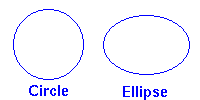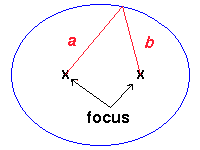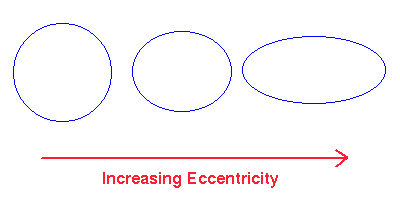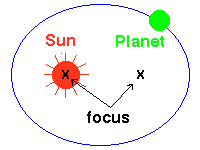
The next great development in the history of astronomy
was the theoretical laws of Johannes Kepler (1571-1630), a
German who went to Prague to become Brahe's assistant.![]()
He set Kepler the task of understanding the orbit of the planet Mars, which was particularly troublesome. It is believed that part of the motivation for giving the Mars problem to Kepler was that it was difficult, and Brahe hoped it would occupy Kepler while Brahe worked on his theory of the Solar System. In a supreme irony, it was precisely the Martian data that allowed Kepler to formulate the correct laws of planetary motion, thus eventually achieving a place in the development of astronomy far surpassing that of Brahe.
 It fell to Kepler to provide the final piece of the puzzle: after a long
struggle, in which he tried mightily to avoid his eventual conclusion, Kepler
was forced finally to the realization that the orbits of the planets were not
the circles demanded by Aristotle and assumed implicitly by Copernicus, but were
instead the "flattened circles" that geometers call ellipses (See
adjacent figure; the planetary orbits are only slightly elliptical and are not
as flattened as in this example.)
It fell to Kepler to provide the final piece of the puzzle: after a long
struggle, in which he tried mightily to avoid his eventual conclusion, Kepler
was forced finally to the realization that the orbits of the planets were not
the circles demanded by Aristotle and assumed implicitly by Copernicus, but were
instead the "flattened circles" that geometers call ellipses (See
adjacent figure; the planetary orbits are only slightly elliptical and are not
as flattened as in this example.)
The irony noted above lies in the realization that the difficulties with the Martian orbit derive precisely from the fact that the orbit of Mars was the most elliptical of the planets for which Brahe had extensive data. Thus Brahe had unwittingly given Kepler the very part of his data that would allow Kepler to eventually formulate the correct theory of the Solar System and thereby to banish Brahe's own theory!
 1. For an ellipse there are two points called foci (singular: focus) such that
the sum of the distances to the foci from any point on the ellipse is a
constant. In terms of the diagram shown to the left, with "x" marking
the location of the foci, we have the equation
1. For an ellipse there are two points called foci (singular: focus) such that
the sum of the distances to the foci from any point on the ellipse is a
constant. In terms of the diagram shown to the left, with "x" marking
the location of the foci, we have the equation
a + b = constant
that defines the ellipse in terms of the distances a and b.2. The amount of "flattening" of the ellipse is termed the eccentricity. Thus, in the following figure the ellipses become more eccentric from left to right. A circle may be viewed as a special case of an ellipse with zero eccentricity, while as the ellipse becomes more flattened the eccentricity approaches one. Thus, all ellipses have eccentricities lying between zero and one.

 3. The long axis of the ellipse is called the major axis, while the
short axis is called the minor axis (adjacent figure). Half of the
major axis is termed a semimajor axis. The length of a semimajor axis
is often termed the size of the ellipse. It can be shown that the average
separation of a planet from the Sun as it goes around its elliptical orbit is
equal to the length of the semimajor axis. Thus, by the "radius" of a
planet's orbit one usually means the length of the semimajor axis.
3. The long axis of the ellipse is called the major axis, while the
short axis is called the minor axis (adjacent figure). Half of the
major axis is termed a semimajor axis. The length of a semimajor axis
is often termed the size of the ellipse. It can be shown that the average
separation of a planet from the Sun as it goes around its elliptical orbit is
equal to the length of the semimajor axis. Thus, by the "radius" of a
planet's orbit one usually means the length of the semimajor axis.
| I. The orbits of the planets are ellipses, with the Sun at one focus of the ellipse. |
 |
Kepler's First Law is illustrated in the image shown
above. The Sun is not at the center of the ellipse, but is instead at one focus
(generally there is nothing at the other focus of the ellipse). The planet then
follows the ellipse in its orbit, which means that the Earth-Sun distance is
constantly changing as the planet goes around its orbit. For purpose of
illustration we have shown the orbit as rather eccentric; remember that the
actual orbits are much less eccentric than this.
| II. The line joining the planet to the Sun sweeps out equal areas in equal times as the planet travels around the ellipse. |
  |
Kepler's second law is illustrated in the preceding
figure. The line joining the Sun and planet sweeps out equal areas in equal
times, so the planet moves faster when it is nearer the Sun. Thus, a planet
executes elliptical motion with constantly changing angular speed as it moves
about its orbit. The point of nearest approach of the planet to the Sun is
termed perihelion; the point of greatest separation is termed aphelion. Hence,
by Kepler's second law, the planet moves fastest when it is near perihelion and
slowest when it is near aphelion.
| III. The ratio of the squares of the revolutionary periods for two planets is equal to the ratio of the cubes of their semimajor axes: |
 |
In this equation P represents the period of revolution for a planet and R represents the length of its semimajor axis. The subscripts "1" and "2" distinguish quantities for planet 1 and 2 respectively. The periods for the two planets are assumed to be in the same time units and the lengths of the semimajor axes for the two planets are assumed to be in the same distance units. Kepler's Third Law implies that the period for a planet to orbit the Sun increases rapidly with the radius of its orbit. Thus, we find that Mercury, the innermost planet, takes only 88 days to orbit the Sun but the outermost planet (Pluto) requires 248 years to do the same.

![]()
or for the length of the semimajor axis, given the period of the planet,
![]()

